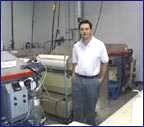
-----
Safety / Environmental Issues in Aluminium Degreasing
Q. I have been asked to assist in the setting up of a aluminium degreasing plant for high volumes of medium size components. I need information on the practical aspects like plant and chemicals and all the health & safety / environmental issues in particular. .. Once again major request for help.
Ziya AhmadAsh & Lacy Perforators - West Midlands, England
2000
A. I am not familiar with the aspects of aluminum degreasing, but one of your first steps should be to identify what kind of chemicals you will be working with and get copies of their MSDS sheets. (Material Safety Data Sheet) This sheet will tell you all of the information you will need to know about health, safety, and similar issues. If you do not have a chemical vendor yet, you can get free copies of MSDS sheets from the University of Vermont at: hazard.com/msds/

Tim Neveau
Rochester Hills, Michigan
2000
A. We put in a trichloroethylene vapour degreaser 3 years ago. One of the major considerations was getting local authority consent. The solvent emissions can be very well controlled (at a cost)so the safety issues are less problematical. If your system gets planning consent you will probably be well inside safety limits. We required as support plant: High pressure hot water and chilled water. The unit had oil superheat and supercooler as standard. It was also not the easiest purchase we have ever made the unit was made in California and assembled on site.
If you can use one of the water based solution degreasers then my advice would be to use one of those. Environmental issues are putting tighter controls on solvents every year. On solution degreasers, lip extraction on the tank is at least advisable and spray rinse on exit as well as dip rinse is worth considering for the ease of tank makeup and solution control particularly on heated solutions. If as your company name suggests you are degreasing perforated aluminium sheets hot air drying is a must after rinsing.
Nordam Europe - Great Britain
2000
2000
A. Hi Ziya,
I liked what Ciaron said about water based solvents & air drying.
Personally I know zilch about trichlor except that it needs
'chilling' to condense the vapours. There used to be (?) a UK solvent called THORPIC which I guess is nearly the same.
One problem you might well have with hot air drying is the cost, obviously, of the heat.
Depending upon the part sizes you want to 'clean' you might like to consider what G.M and Blackstone (both mfgs of car radiators) amongst others, did.
They used an ambient air WIPE to blast off the droplets (alkaline, I believe) at high velocity. Works very well except for droplet carry-over. The Swedish Company of Oelstrom made the original Blackstone (sic. Chrysler) spray box but this used both a push fan and an exhaust fan with an eliminator (mist type eliminator, I mean) in between.
An improvement was made using only one fan and a far better mist eliminator but the design was vetoed originally by the U.S. parent Company ... who later on COPIED, would you believe, this successful approach! Made my day!
In the UK there used to be (?) a Company called Plastic Constructions in Birmingham whose eliminators, blade type (blades were made by Euroform of Aachen) were of excellent quality.
Maybe this might be of some help. I dunno. Here's hoping!
Cheers !

Freeman Newton [deceased]
(It is our sad duty to advise that Freeman passed away
April 21, 2012. R.I.P. old friend).
A. The cleaning of the Al. surface depends largely on the type of lubricant used in the process when the parts are made. We do Al drawing the surface of the finished product has to be super clean in order to meet the end results after the next process operations, what has worked for us so far is the use of Ultrasonic cleaning bath, the chemical used for the removal of the lubricants is a hydroxide base, the process is limited in speeds and requires some maintenance, the used solvents can be neutralized for disposal.
Best regards,
- Milford, New Hampshire, USA
2002
Q, A, or Comment on THIS thread -or- Start a NEW Thread